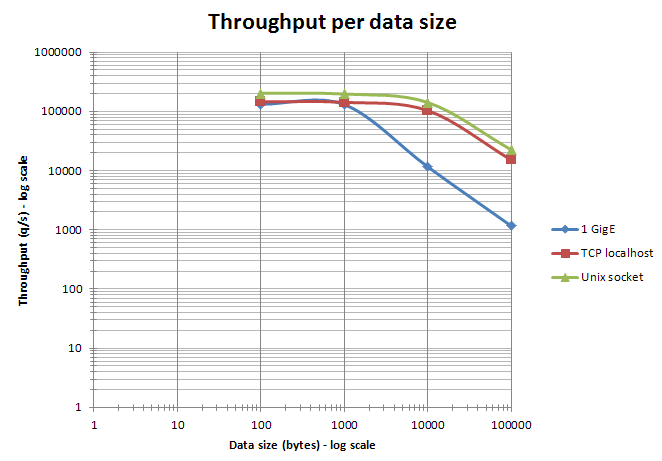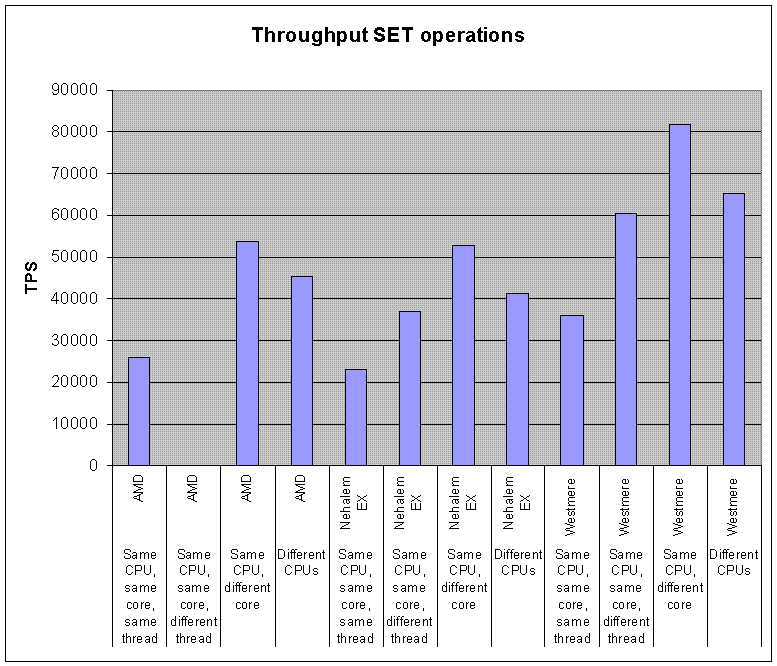原文地址 http://redis.io/topics/benchmarks。
拖了一个半月的稿子~
Redis 自带了一个叫 redis-benchmark 的工具来模拟 N 个客户端同时发出 M 个请求。
(类似于 Apache ab 程序)。你可以使用 redis-benchmark -h 来查看基准参数。
以下参数被支持:
Usage: redis-benchmark [-h <host>] [-p <port>] [-c <clients>] [-n <requests]> [-k <boolean>]
-h <hostname> Server hostname (default 127.0.0.1)
-p <port> Server port (default 6379)
-s <socket> Server socket (overrides host and port)
-c <clients> Number of parallel connections (default 50)
-n <requests> Total number of requests (default 10000)
-d <size> Data size of SET/GET value in bytes (default 2)
-k <boolean> 1=keep alive 0=reconnect (default 1)
-r <keyspacelen> Use random keys for SET/GET/INCR, random values for SADD
Using this option the benchmark will get/set keys
in the form mykey_rand:000000012456 instead of constant
keys, the <keyspacelen> argument determines the max
number of values for the random number. For instance
if set to 10 only rand:000000000000 - rand:000000000009
range will be allowed.
-P <numreq> Pipeline <numreq> requests. Default 1 (no pipeline).
-q Quiet. Just show query/sec values
--csv Output in CSV format
-l Loop. Run the tests forever
-t <tests> Only run the comma separated list of tests. The test
names are the same as the ones produced as output.
-I Idle mode. Just open N idle connections and wait.
你需要在基准测试之前启动一个 Redis 实例。一般这样启动测试:
redis-benchmark -q -n 100000
这个工具使用起来非常方便,同时你可以使用自己的基准测试工具, 不过开始基准测试时候,我们需要注意一些细节。
只运行一些测试用例的子集
你不必每次都运行 redis-benchmark 默认的所有测试。
使用 -t 参数可以选择你需要运行的测试用例,比如下面的范例:
$ redis-benchmark -t set,lpush -n 100000 -q
SET: 74239.05 requests per second
LPUSH: 79239.30 requests per second
在上面的测试中,我们只运行了 SET 和 LPUSH 命令,
并且运行在安静模式中(使用 -q 参数)。
也可以直接指定命令来直接运行,比如下面的范例:
$ redis-benchmark -n 100000 -q script load "redis.call('set','foo','bar')"
script load redis.call('set','foo','bar'): 69881.20 requests per second
选择测试键的范围大小
默认情况下面,基准测试使用单一的 key。在一个基于内存的数据库里, 单一 key 测试和真实情况下面不会有巨大变化。当然,使用一个大的 key 范围空间, 可以模拟现实情况下面的缓存不命中情况。
这时候我们可以使用 -r 命令。比如,假设我们想设置 10 万随机 key
连续 SET 100 万次,我们可以使用下列的命令:
$ redis-cli flushall
OK
$ redis-benchmark -t set -r 100000 -n 1000000
====== SET ======
1000000 requests completed in 13.86 seconds
50 parallel clients
3 bytes payload
keep alive: 1
99.76% `<=` 1 milliseconds
99.98% `<=` 2 milliseconds
100.00% `<=` 3 milliseconds
100.00% `<=` 3 milliseconds
72144.87 requests per second
$ redis-cli dbsize
(integer) 99993
使用 pipelining
默认情况下,每个客户端都是在一个请求完成之后才发送下一个请求
(benchmark 会模拟 50 个客户端除非使用 -c 指定特别的数量),
这意味着服务器几乎是按顺序读取每个客户端的命令。Also RTT is payed as well.
真实世界会更复杂,Redis 支持 /topics/pipelining,使得可以一次性执行多条命令成为可能。 Redis pipelining 可以提高服务器的 TPS。
下面这个案例是在 Macbook air 11" 上使用 pipelining 组织 16 条命令的测试范例:
$ redis-benchmark -n 1000000 -t set,get -P 16 -q
SET: 403063.28 requests per second
GET: 508388.41 requests per second
记得在多条命令需要处理时候使用 pipelining。
陷阱和错误的认识
第一点是显而易见的:基准测试的黄金准则是使用相同的标准。 用相同的任务量测试不同版本的 Redis,或者用相同的参数测试测试不同版本 Redis。 如果把 Redis 和其他工具测试,那就需要小心功能细节差异。
- Redis 是一个服务器:所有的命令都包含网络或 IPC 消耗。这意味着和它和 SQLite, Berkeley DB, Tokyo/Kyoto Cabinet 等比较起来无意义, 因为大部分的消耗都在网络协议上面。
- Redis 的大部分常用命令都有确认返回。有些数据存储系统则没有(比如 MongoDB 的写操作没有返回确认)。把 Redis 和其他单向调用命令存储系统比较意义不大。
- 简单的循环操作 Redis 其实不是对 Redis 进行基准测试,而是测试你的网络(或者 IPC)延迟。想要真正测试 Redis,需要使用多个连接(比如 redis-benchmark), 或者使用 pipelining 来聚合多个命令,另外还可以采用多线程或多进程。
- Redis 是一个内存数据库,同时提供一些可选的持久化功能。 如果你想和一个持久化服务器(MySQL, PostgreSQL 等等) 对比的话, 那你需要考虑启用 AOF 和适当的 fsync 策略。
- Redis 是单线程服务。它并没有设计为多 CPU 进行优化。如果想要从多核获取好处, 那就考虑启用多个实例吧。将单实例 Redis 和多线程数据库对比是不公平的。
一个普遍的误解是 redis-benchmark 特意让基准测试看起来更好, 所表现出来的数据像是人造的,而不是真实产品下面的。
Redis-benchmark 程序可以简单快捷的对给定硬件条件下面的机器计算出性能参数。 但是,通常情况下面这并不是 Redis 服务器可以达到的最大吞吐量。 事实上,使用 pipelining 和更快的客户端(hiredis)可以达到更大的吞吐量。 redis-benchmark 默认情况下面仅仅使用并发来提高吞吐量(创建多条连接)。 它并没有使用 pipelining 或者其他并行技术(仅仅多条连接,而不是多线程)。
如果想使用 pipelining 模式来进行基准测试(了达到更高吞吐量),可以使用 -P
参数。这种方案的确可以提高性能,有很多使用 Redis 的应用在生产环境中这样做。
最后,基准测试需要使用相同的操作和数据来对比,如果这些不一样, 那么基准测试是无意义的。
比如,Redis 和 memcached 可以在单线程模式下面对比 GET/SET 操作。 两者都是内存数据库,协议也基本相同,甚至把多个请求合并为一条请求的方式也类似 (pipelining)。在使用相同数量的连接后,这个对比是很有意义的。
下面这个很不错例子是在 Redis(antirez)和 memcached(dormando)测试的。
antirez 1 - On Redis, Memcached, Speed, Benchmarks and The Toilet
dormando - Redis VS Memcached (slightly better bench)
antirez 2 - An update on the Memcached/Redis benchmark
你可以发现相同条件下面最终结果是两者差别不大。请注意最终测试时候, 两者都经过了充分优化。
最后,当特别高性能的服务器在基准测试时候(比如 Redis、memcached 这类), 很难让服务器性能充分发挥,通常情况下,客户端回事瓶颈限制而不是服务器端。 在这种情况下面,客户端(比如 benchmark 程序自身)需要优化,或者使用多实例, 从而能达到最大的吞吐量。
影响 Redis 性能的因素
有几个因素直接决定 Redis 的性能。它们能够改变基准测试的结果, 所以我们必须注意到它们。一般情况下,Redis 默认参数已经可以提供足够的性能, 不需要调优。
- 网络带宽和延迟通常是最大短板。建议在基准测试之前使用 ping 来检查服务端到客户端的延迟。根据带宽,可以计算出最大吞吐量。 比如将 4 KB 的字符串塞入 Redis,吞吐量是 100000 q/s,那么实际需要 3.2 Gbits/s 的带宽,所以需要 10 GBits/s 网络连接, 1 Gbits/s 是不够的。 在很多线上服务中,Redis 吞吐会先被网络带宽限制住,而不是 CPU。 为了达到高吞吐量突破 TCP/IP 限制,最后采用 10 Gbits/s 的网卡, 或者多个 1 Gbits/s 网卡。
- CPU 是另外一个重要的影响因素,由于是单线程模型,Redis 更喜欢大缓存快速 CPU, 而不是多核。这种场景下面,比较推荐 Intel CPU。AMD CPU 可能只有 Intel CPU 的一半性能(通过对 Nehalem EP/Westmere EP/Sandy 平台的对比)。 当其他条件相当时候,CPU 就成了 redis-benchmark 的限制因素。
- 在小对象存取时候,内存速度和带宽看上去不是很重要,但是对大对象(> 10 KB), 它就变得重要起来。不过通常情况下面,倒不至于为了优化 Redis 而购买更高性能的内存模块。
- Redis 在 VM 上会变慢。虚拟化对普通操作会有额外的消耗,Redis 对系统调用和网络终端不会有太多的 overhead。建议把 Redis 运行在物理机器上, 特别是当你很在意延迟时候。在最先进的虚拟化设备(VMWare)上面,redis-benchmark 的测试结果比物理机器上慢了一倍,很多 CPU 时间被消费在系统调用和中断上面。
- 如果服务器和客户端都运行在同一个机器上面,那么 TCP/IP loopback 和 unix domain sockets 都可以使用。对 Linux 来说,使用 unix socket 可以比 TCP/IP loopback 快 50%。 默认 redis-benchmark 是使用 TCP/IP loopback。
- 当大量使用 pipelining 时候,unix domain sockets 的优势就不那么明显了。
- 当使用网络连接时,并且以太网网数据包在 1500 bytes 以下时, 将多条命令包装成 pipelining 可以大大提高效率。事实上,处理 10 bytes,100 bytes, 1000 bytes 的请求时候,吞吐量是差不多的,详细可以见下图。

- 在多核 CPU 服务器上面,Redis 的性能还依赖 NUMA 配置和 处理器绑定位置。 最明显的影响是 redis-benchmark 会随机使用 CPU 内核。为了获得精准的结果, 需要使用固定处理器工具(在 Linux 上可以使用 taskset 或 numactl)。 最有效的办法是将客户端和服务端分离到两个不同的 CPU 来高校使用三级缓存。 这里有一些使用 4 KB 数据 SET 的基准测试,针对三种 CPU(AMD Istanbul, Intel Nehalem EX, 和 Intel Westmere)使用不同的配置。请注意, 这不是针对 CPU 的测试。

- 在高配置下面,客户端的连接数也是一个重要的因素。得益于 epoll/kqueue, Redis 的事件循环具有相当可扩展性。Redis 已经在超过 60000 连接下面基准测试过, 仍然可以维持 50000 q/s。一条经验法则是,30000 的连接数只有 100 连接的一半吞吐量。 下面有一个关于连接数和吞吐量的测试。

- 在高配置下面,可以通过调优 NIC 来获得更高性能。最高性能在绑定 Rx/Tx 队列和 CPU 内核下面才能达到,还需要开启 RPS(网卡中断负载均衡)。更多信息可以在 thread 。Jumbo frames 还可以在大对象使用时候获得更高性能。
- 在不同平台下面,Redis 可以被编译成不同的内存分配方式(libc malloc, jemalloc, tcmalloc),他们在不同速度、连续和非连续片段下会有不一样的表现。 如果你不是自己编译的 Redis,可以使用 INFO 命令来检查内存分配方式。 请注意,大部分基准测试不会长时间运行来感知不同分配模式下面的差异, 只能通过生产环境下面的 Redis 实例来查看。
其他需要注意的点
任何基准测试的一个重要目标是获得可重现的结果,这样才能将此和其他测试进行对比。
- 一个好的实践是尽可能在隔离的硬件上面测试。如果没法实现,那就需要检测 benchmark 没有受其他服务器活动影响。
- 有些配置(桌面环境和笔记本,有些服务器也会)会使用可变的 CPU 分配策略。 这种策略可以在 OS 层面配置。有些 CPU 型号相对其他能更好的调整 CPU 负载。 为了达到可重现的测试结果,最好在做基准测试时候设定 CPU 到最高使用限制。
- 一个重要因素是配置尽可能大内存,千万不要使用 SWAP。注意 32 位和 64 位 Redis 有不同的内存限制。
- 如果你计划在基准测试时候使用 RDB 或 AOF,请注意不要让系统同时有其他 I/O 操作。 避免将 RDB 或 AOF 文件放到 NAS 或 NFS 共享或其他依赖网络的存储设备上面(比如 Amazon EC2 上 的 EBS)。
- 将 Redis 日志级别设置到 warning 或者 notice。避免将日志放到远程文件系统。
- 避免使用检测工具,它们会影响基准测试结果。使用 INFO 来查看服务器状态没问题, 但是使用 MONITOR 将大大影响测试准确度。
不同云主机和物理机器上的基准测试结果
- 这些测试模拟了 50 客户端和 200w 请求。
- 使用了 Redis 2.6.14。
- 使用了 loopback 网卡。
- key 的范围是 100 w。
- 同时测试了 有 pipelining 和没有的情况(16 条命令使用 pipelining)。
Intel(R) Xeon(R) CPU E5520 @ 2.27GHz (with pipelining)
$ ./redis-benchmark -r 1000000 -n 2000000 -t get,set,lpush,lpop -P 16 -q
SET: 552028.75 requests per second
GET: 707463.75 requests per second
LPUSH: 767459.75 requests per second
LPOP: 770119.38 requests per second
Intel(R) Xeon(R) CPU E5520 @ 2.27GHz (without pipelining)
$ ./redis-benchmark -r 1000000 -n 2000000 -t get,set,lpush,lpop -q
SET: 122556.53 requests per second
GET: 123601.76 requests per second
LPUSH: 136752.14 requests per second
LPOP: 132424.03 requests per second
Linode 2048 instance (with pipelining)
$ ./redis-benchmark -r 1000000 -n 2000000 -t get,set,lpush,lpop -q -P 16
SET: 195503.42 requests per second
GET: 250187.64 requests per second
LPUSH: 230547.55 requests per second
LPOP: 250815.16 requests per second
Linode 2048 instance (without pipelining)
$ ./redis-benchmark -r 1000000 -n 2000000 -t get,set,lpush,lpop -q
SET: 35001.75 requests per second
GET: 37481.26 requests per second
LPUSH: 36968.58 requests per second
LPOP: 35186.49 requests per second
更多使用 pipeline 的测试
$ redis-benchmark -n 100000
====== SET ======
100007 requests completed in 0.88 seconds
50 parallel clients
3 bytes payload
keep alive: 1
58.50% <= 0 milliseconds
99.17% <= 1 milliseconds
99.58% <= 2 milliseconds
99.85% <= 3 milliseconds
99.90% <= 6 milliseconds
100.00% <= 9 milliseconds
114293.71 requests per second
====== GET ======
100000 requests completed in 1.23 seconds
50 parallel clients
3 bytes payload
keep alive: 1
43.12% <= 0 milliseconds
96.82% <= 1 milliseconds
98.62% <= 2 milliseconds
100.00% <= 3 milliseconds
81234.77 requests per second
====== INCR ======
100018 requests completed in 1.46 seconds
50 parallel clients
3 bytes payload
keep alive: 1
32.32% <= 0 milliseconds
96.67% <= 1 milliseconds
99.14% <= 2 milliseconds
99.83% <= 3 milliseconds
99.88% <= 4 milliseconds
99.89% <= 5 milliseconds
99.96% <= 9 milliseconds
100.00% <= 18 milliseconds
68458.59 requests per second
====== LPUSH ======
100004 requests completed in 1.14 seconds
50 parallel clients
3 bytes payload
keep alive: 1
62.27% <= 0 milliseconds
99.74% <= 1 milliseconds
99.85% <= 2 milliseconds
99.86% <= 3 milliseconds
99.89% <= 5 milliseconds
99.93% <= 7 milliseconds
99.96% <= 9 milliseconds
100.00% <= 22 milliseconds
100.00% <= 208 milliseconds
88109.25 requests per second
====== LPOP ======
100001 requests completed in 1.39 seconds
50 parallel clients
3 bytes payload
keep alive: 1
54.83% <= 0 milliseconds
97.34% <= 1 milliseconds
99.95% <= 2 milliseconds
99.96% <= 3 milliseconds
99.96% <= 4 milliseconds
100.00% <= 9 milliseconds
100.00% <= 208 milliseconds
71994.96 requests per second
注意:包大小从 256 到 1024 或者 4096 bytes 不会改变结果的量级 (但是到 1024 bytes 后,GETs 操作会变慢)。同样的,50 到 256 客户端的测试结果相同。 10 个客户端时候,吞吐量会变小(译者按:总量到不了最大吞吐量)。
不同机器可以获的不一样的结果,下面是 Intel T5500 1.66 GHz 在 Linux 2.6 下面的结果:
$ ./redis-benchmark -q -n 100000
SET: 53684.38 requests per second
GET: 45497.73 requests per second
INCR: 39370.47 requests per second
LPUSH: 34803.41 requests per second
LPOP: 37367.20 requests per second
另外一个是 64 位 Xeon L5420 2.5 GHz 的结果:
$ ./redis-benchmark -q -n 100000
PING: 111731.84 requests per second
SET: 108114.59 requests per second
GET: 98717.67 requests per second
INCR: 95241.91 requests per second
LPUSH: 104712.05 requests per second
LPOP: 93722.59 requests per second
高性能硬件下面的基准测试
- Redis 2.4.2。
- 默认连接数,数据包大小 256 bytes。
- Linux 是 SLES10 SP3 2.6.16.60-0.54.5-smp,CPU 是 2 x Intel X5670 @ 2.93 GHz。
- 固定 CPU,但是使用不同 CPU 内核。
使用 unix domain socket:
$ numactl -C 6 ./redis-benchmark -q -n 100000 -s /tmp/redis.sock -d 256
PING (inline): 200803.22 requests per second
PING: 200803.22 requests per second
MSET (10 keys): 78064.01 requests per second
SET: 198412.69 requests per second
GET: 198019.80 requests per second
INCR: 200400.80 requests per second
LPUSH: 200000.00 requests per second
LPOP: 198019.80 requests per second
SADD: 203665.98 requests per second
SPOP: 200803.22 requests per second
LPUSH (again, in order to bench LRANGE): 200000.00 requests per second
LRANGE (first 100 elements): 42123.00 requests per second
LRANGE (first 300 elements): 15015.02 requests per second
LRANGE (first 450 elements): 10159.50 requests per second
LRANGE (first 600 elements): 7548.31 requests per second
使用 TCP loopback:
$ numactl -C 6 ./redis-benchmark -q -n 100000 -d 256
PING (inline): 145137.88 requests per second
PING: 144717.80 requests per second
MSET (10 keys): 65487.89 requests per second
SET: 142653.36 requests per second
GET: 142450.14 requests per second
INCR: 143061.52 requests per second
LPUSH: 144092.22 requests per second
LPOP: 142247.52 requests per second
SADD: 144717.80 requests per second
SPOP: 143678.17 requests per second
LPUSH (again, in order to bench LRANGE): 143061.52 requests per second
LRANGE (first 100 elements): 29577.05 requests per second
LRANGE (first 300 elements): 10431.88 requests per second
LRANGE (first 450 elements): 7010.66 requests per second
LRANGE (first 600 elements): 5296.61 requests per second
原文链接: Redis 到底有多快[译文] | Log4D
3a1ff193cee606bd1e2ea554a16353ee
欢迎关注我的微信公众号:窥豹
